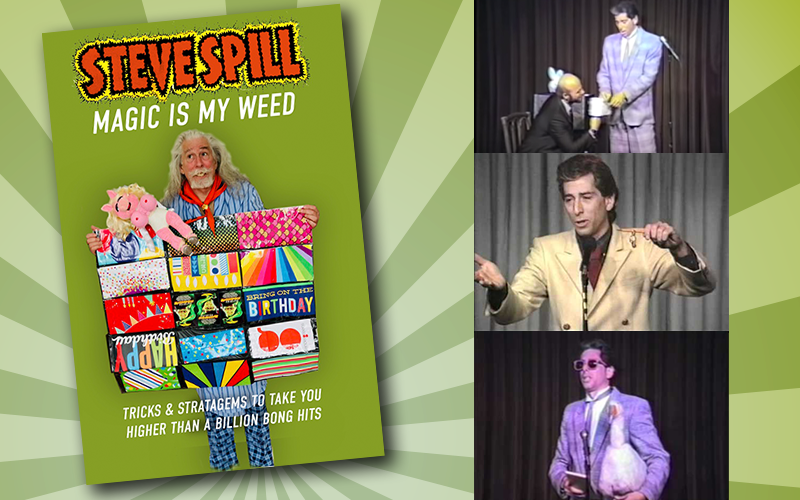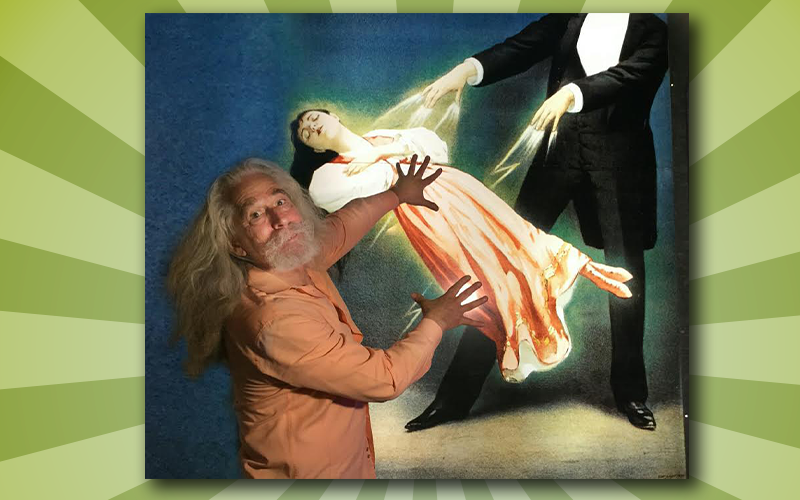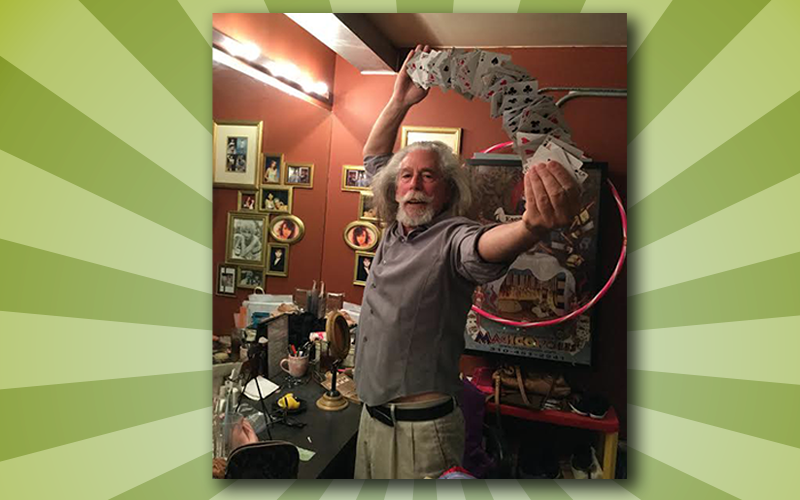Submitted by Jamy Ian Swiss on
Magic is My Weed
Tricks and Stratagems to Take You Higher Than a Billion Bong Hits
by Steve Spill
Reviewed by Jamy Ian Swiss
I don’t know how Steve Spill does it. Just over a year ago, I reviewed his then newly released book of stage and platform magic, How to Make Love the Steve Spill Way. That remarkable work was devoted to, in the author’s words, instructing the reader in “[H]ow to share with audiences who you are, how to integrate comedy, and develop your own original material.” In 277 pages, Spill did a superb job of providing such a guide, with in-depth consideration of the how-to elements, based on his vast career experience, coupled with the detailed descriptions of twelve powerhouse routines—several of which could serve as the foundation of anyone’s professional standup act. In that review, I wrote:
So what we have here is a remarkable guidebook to the professional performance of comedy stage magic, written—from the heart as well as the mind—by a successful veteran working pro who is also one of the most original and creative magicians of his generation. With unusual frankness as well as expertise—and in a distinctively stylistic and comedic voice—you receive professional guidance about character, comedy, creativity, originality, presentation and scriptwriting, and no less than a dozen professional caliber audience tested routines complete with original presentations, featuring three blockbuster pieces, any one of which could become the feature of your show.
In my 2016 Take Two essay about Steve, I recounted how quickly he could come up with an idea, make a run to the arts and crafts shop, put together the props, and within a few days—if that—put the routine on stage to see what might happen. It is apparent that he is as fearless and driven when it comes to writing books, because now, just over a year after the release of its predecessor, Steve Spill gifts us with his second substantial volume of stage and comedy magic, featuring another dozen polished professional stage routines, preceded by six meaty chapters of theory and practice about real-world performance skills.
After recently selling Magicopolis, the unique magic venue that Spill founded and operated for some twenty years in Santa Monica, he takes the experience of not hundreds of shows, not thousands, but of literally tens of thousands of paid professional shows, and in these pages, delivers, without holding anything back, what he’s learned. You will rarely find comparable lessons and experience elsewhere.
The book opens with “Let’s Party!”, in which Spill explains the book’s title, offering that while his days of recreational drugs are long behind him, the pleasure of creating and performing original magic continue to produce his greatest highs. In these initial pages, Spill contemplates his evolutions and influences, offers further discussion about performance character, including his own, and provides a thoughtful viewpoint about magic as art, craft, business and lifestyle. These pages are not only unusual for the amount of personal and professional experience that Spill brings to the table, but they also border on being unprecedented for their inordinately frank and straightforward commentary—all the while being funny and irreverent. Deeply personal at moments, this content is also powerfully instructive. In concluding this introductory chapter, Spill invites us to what’s in store, explaining that:
As an entertainer I am keen to please people, as many in an audience as possible. I want them to love what I do, but during the writing of this book, I have kept that guy chained, gagged, and locked in a lead-lined box under my bed. The routines described herein were designed so audiences respond viscerally to each trick and joke. Writing about them and how they are accomplished is another story. You see, my desired outcome here in this book doesn’t include a responsible attempt to please all the people all the time. But I do want the words ahead to be strictly honest, accurate, instructional, inspiring—and if possible, an aid in the journey for some of my colleagues who strive to find a new, different, or funny path. I also want to make you laugh and think and feel. So there you have it.
The next chapter, “Spur of the Moment,” is about the role of spontaneity in performance—both planned and genuine. In the previous chapter the author comments that, “To me, part of the beauty of magic is to project an assumed air of doing difficult things with an effortless mastery and the feel of nonchalance so as to make them look easy. This is part of giving what we do a sense of spontaneity, even though it is a result of acting and practice and rehearsal.” In this chapter he examines, in the most instructive detail I have ever come across, how to create that air of spontaneity. He writes:
An improvisational attitude encourages one to be flexible and adapt – so that a fresh discovery is always waiting around the corner. I firmly believe that improvisation enhances one’s performance, increases confidence, and builds self-esteem. It is an important and crucial part of establishing an atmosphere and connection to a crowd. When one is doing their act, there’s a rhythm the audience creates that’s essential. When they are engaged and involved they are the most reactive. Crafting that collective attitude, being able to customize it, to personalize it on the fly, is an essential part of performing. Being spontaneous and instinctive, speaking extemporaneously, being able to think on your feet in front of an audience—are extra human-touch presentational efforts that fall into two categories. Both of these skillsets enhance the enjoyment of a performance and make the audience feel they are part of the process, like we’re all in this together. … I wrote together, even though technically it is more about you than them, but it should feel to them like the show is more about them. The more you invest in the audience the more they invest in you.
Now, sure, you’re thinking that makes sense, but it’s a lot easier to say than to do. Fortunately, the author then plunges into an in-depth discussion of how to actually learn to do this in front of an audience, how to expand and hone one’s ability to ad-lib and bring spontaneity to a show. Spill provides not only general guidance but also practical exercises that enable aspiring performers to think about, to practice, and to improve these skills, in ways that have produced palpable results in the course of his five decades s of professional performance.
In the course of this instruction, Spill breaks things down and analyzes how comedy magic on stage is different than standup comedy or improv comedy, to wit:
Improvising as a magician onstage and being funny without any preparation or planning. This is about honest discovery and observation, with nothing contrived or invented beforehand. The improv techniques of a comedy magician are a bit different than a set-up and punchline stand-up comic monologist, and are completely different than the type described in a gazillion texts that are executed by an ensemble of trained comedy actors interacting with each other.
Here is golden advice from a top pro, an analytical and insightful expert. He provides tools for become more improvisational on stage, and how to make the results funny—including describing a simple system he dubs “PESK,” which stands for Punch, Exaggerate, Specificity—and “the K sound.” This, and so much more within these pages, amounts to simply the best real-world instructional guidance I have come across for creating a sense of immediacy—and laughs—on stage.
In the next chapter, “OA,” the author discusses “callbacks” and “tags,” comedy techniques that involve referring back to earlier jokes or incidents, or references that serve to add multiple laughs on as extensions to an initial joke or gag. Spill’s “OA” is a specific, manufactured callback technique based on audience participation that he has used for years. He explains in detail how it was created, and how it provides an extended and repeating gag that, for those whom it might fit, is a surefire results-oriented laugh-getter.
I’ve long thought of Steve Spill as a laid back deadpan wordsmith, whose material kills the hardest with audiences that are smart and paying attention. I don’t think I’m wrong about that, but in over twenty years of doing family shows at Magicopolis, he has developed and fine-tuned the ability to thoroughly and consistently entertain audiences of all types and ages. In “The Dope on Young Humans,” he provides terrific guidance on how to expand your range to include children, without stooping to standard birthday party tricks and props. Along the way he details a running gag that, as he explains, amounts to “… a secret for keeping children entertained and attentive over the course of a seventy-minute show.” And he adds, “I’ve successfully implemented this technique literally thousands of times.”
Continuing along related lines, the title of the next chapter, “Paparazzi,” refers to a similarly priceless bit that Spill has developed when working for audiences of teenagers rather than children. The extended and virtually foolproof bit described here is something that the author might use, as a callback for teens, perhaps three to five times in a ninety-minute show. He posits: “Is it risky? Maybe. Crude? A little. Does it capture an audience of high school graduates? Yes. Funny? Yes to that as well. And those two latter facts are the whole point.” For some performers, either one of these chapters, much less both, might well amount to a value far greater than the price of the book.
The final chapter of this theory and craft section is entitled “Thick Skin,” and is about how to develop one if you’re going to become a successful performer of any kind, but especially of the comical type. Standup comics will readily tell you how badly they’ve bombed on stage, and how often—and even the best, especially the more creative and risk-taking ones, still risk it with every outing. In this chapter, Spill recounts “some of the most miserable experiences of my career.” It’s brutal to read, and far more brutal, I would think, to be willing to confess to it and narrate the details to the rest of us. “But,” he adds, “bombing is good for you. Like eating your vegetables. It makes you strong. It permanently alters your molecules and recalibrates your fear sensors. It thickens your skin and makes you stronger in ways that come in handy down the road. Yes, bombing makes you feel inadequate, but that can drive you to prove you are not. There is nothing that sears itself into one’s memory more indelibly than traumatic events, but as a special bonus, these negative things are now useful to me as part of this chapter. From bad to worse, here are some of my most humbling humiliations that will uncurl your short hairs.”
And yes, if you’ve been on stage enough, you’ve been there—we’ve all been there. (In fact, now that I think about it, one of the times I "was there," well over twenty years ago, was in a brutal corporate show at which Spill and I shared the stage.) I commend the author for his courage in sharing these tales, in the selfless pursuit of educating his readers to the real work about performance and comedy. And under the heading of his pain is our pleasure, the author recounts at least one such anecdote that is literally laugh-out-loud hilarious. Maybe two.
Now, truth be told, I think this book would be a uniquely invaluable volume if it concluded right there. But instead, Steve Spill now presents readers with a dozen original routines that are absolutely astounding in their quality and potential usefulness. Of the dozen routines in the previous book, at least two or three were masterpieces that could serve to ground any full-time pro’s act. Here, the author does it again.
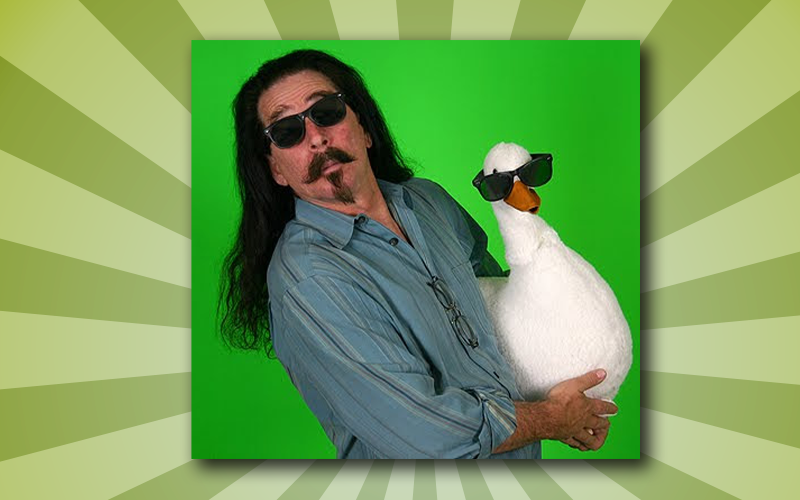
This time around I’m not going to detail every piece. In brief: There’s a mental effect with restaurant menus; another platform mental effect with business cards; a Miser’s Dream with a distinct and visual climax. There is a routine that uses a Multiplying Bottles set in a way I can guarantee no one has ever thought of before. There’s an updated version of the spirit slates plot that, thank goodness, does away with the slates. There’s a multi-phase sleight-of-hand routine with a Cub Scout neckerchief and “slide” ring. There’s a clever and funny application of a Grant Buddha Temple Screen (including instructions for how to build one) that involves a presentation about visiting an art museum and a “Renaissance nude.” There is a take on a torn-and-restored effect that comes with a presentation designed on the theme of Mother’s Day that will bring some audiences to tears and that many of those audience members will simply never forget.
And then there are the Mind-Reading Goose; Grab ‘n Stab; and the Rice Paper. These simply demand my taking some time to talk about.
I’m pretty certain that the first routine I ever saw Steve Spill perform was the Mind-Reading Goose. I recall thinking at the time that the piece told me a tremendous amount about the performer. It introduced Steve’s on-stage persona in a perfectly delineated fashion—that laid-back, wisecracking hipster. (He describes himself more as an aging hippie these days, but there was nothing hippie about him back then—albeit he was thoroughly wisecracking.) In the performance of a single routine, he painted a beautifully crafted on-stage picture. It was instantly clear that he was a terrific magical thinker—one who had taken the ancient idea of the cents-in-the-pocket mentalism effect (both effect and method, in fact), and applied it in a virtually unrecognizable manner—one that was scintillatingly contemporary, hilarious, and original. Not bad for a few minutes with a goose puppet in your arms.
The Mind-Reading Goose is truly a signature Steve Spill routine. It has been marketed at one time for a very high price, more than a thousand dollars, and professionals jumped at the opportunity to own and perform it. Then again, countless pros have also jumped at that opportunity without having the any right whatsoever to perform it, or spending as much as a British pound sterling beyond the cost of the puppet to own it. To say this routine is worth the price of this book is ludicrous, because it is worth many times the price of the book, and has literally sold for as much in the past. And I needn’t describe it further, because below you will find a link to a performance, from the era in which I first witnessed it and laughed my ass off at it.
You’ll also find a link to a performance of Grab ‘n Stab, yet another entirely original comic and visual masterpiece. This is basically Russian Roulette with a bag of knives, where the magician hopes to grab the one fake collapsible knife out of a transparent bagful of genuine knives, immediately stabbing himself in the chest—and things don’t go entirely as planned. The double-beat visual punchlines on this are unforgettable images for audiences.
And then, there’s the Rice Paper. No matter how hard I laughed the first time I saw the Mindreading Goose, I didn’t laugh as hard as I did at the Rice Paper trick.
Rice Paper is a version of Slydini’s Paper Balls Over the Head, that Steve Spill developed and refined in performances with Bob Sheets, when they were doing nightly shows of the Bob & Steve Magic-Comedy Cabaret show at the Brook Farm Inn of Magic in Chevy Chase, Maryland. You can read more about that history in my Take Two about Spill, and in my review of Steve’s previous book. But suffice to say, to this day that show remains one of the two or three funniest comedy magic shows I’ve ever seen, and the Rice Papers was a highlight—one of the three routines that Bob and Steve performed together in the course of the show (along with the levitation and the Sub Trunk).
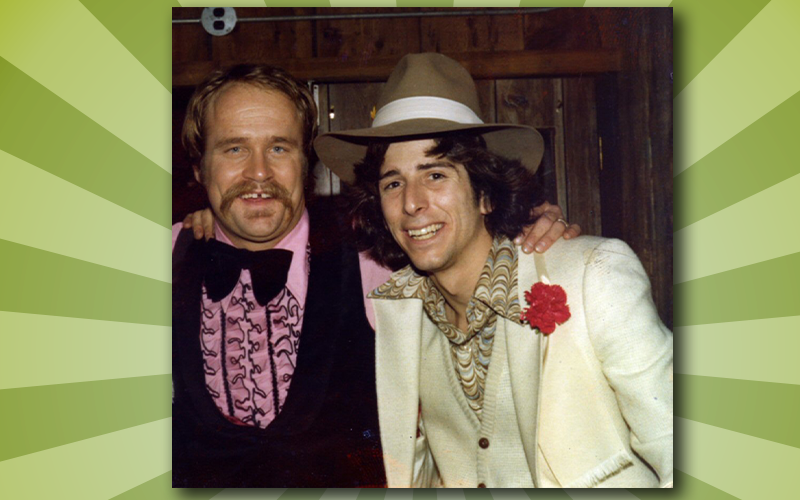
Now, I had the pleasure in my youth of watching Slydini perform in person many, many times, more times than I can count, both close-up and on stage. And I can tell you that I have very little patience for most performances of the Paper Balls Over the Head that I’ve seen since, because few—very few—performers understand how mystifying the routine was in Slydini’s hands, for both the larger audience as well as for the on-stage spectator. Yes, the audience knew where the balls were going, but they didn’t really understand why the guy in the chair wasn’t seeing it. That’s a key and powerful difference in the effect between Slydini’s performance and most others I’ve since witnessed.
The unfortunate truth is that anyone can get a laugh—and worse still, convince himself that he’s funny—by doing some ham-fisted “which hands” crap and then literally throwing the balls over the spectator’s head so that he lacks the slightest chance of ever seeing them fly. It’s a truth I’ve seen the proof of countless times.
This is part of why I respect Steve’s version, because he understands how to deepen the power of the effect with skill and subtlety.
But that’s the least of it. The key thing with the Rice Paper routine is that there’s a role for a second person, who is in cahoots with the performer. Back in the Brook Farm days that person was Bob Sheets, the other stage performer in the show, who was apparently—at least, to the on-stage spectator—sitting way up in a balcony in the back of the theater, watching and being amazed as every ball vanished. When Steve would ask how it looked, Bob would shout from the balcony, “It looks great from up here, Steve.”
But what the on-stage assistant didn’t know was that between every vanish, Bob was racing down the staircase in order to be on stage, immediately behind the spectator, just in the nick of time, ready to catch the ball as Steve tossed it over the spectator’s head; whereupon Bob would race back around the room and up the stairs to the balcony, just in time to respond to Steve’s request for his opinion.
As the routine moved into its later phases, Steve would ask again how the trick looked, and Bob would breathlessly gasp from the back of the house, “I don’t know about you, but it’s killing me, Steve.” This was beyond hilarious. This was fall-off-your-chair, gasping-for-air, madness.
In later years, the second performer has long been Steve’s talented life partner, Bozena, perched in the lighting booth, apparently in order to operate the follow spot. Now, Steve Spill takes every word of this routine, every detail, every nuance, every action, every beat, and lays it all out on the page. It is all here, for the mere purchase price of this book.
As Bob Sheets used to shout from the balcony: “I can’t believe it!”
I don’t know what more I need to tell you in order to help convey how valuable I think this book is. I simply don’t know of a better book of real-world counsel on what it takes to perform professionally on stage, to make a living at it, and to be funny in the process. In Magic Is My Weed, Steve Spill unloads a bucketful—a lifespan load—of knowledge and advice that will keep you learning, and laughing too, for years to come. My advice: grab yourself a toke, now.
—♦—
Magic Is My Weed by Steve Spill (2019). Laminated hardcover, 287 pages, illustrated with drawings by the author. Published by the author. Price: $125 US, $150 international. Order via PayPal: info@stevespill.com or visit https://magicopolis.com/magicians-only/
And...
As promised, here are links to performances of two routines featured in Magic Is My Weed by Steve Spill:
Steve Spill's Mind Reading Goose
Steve Spill / Grab ‘n Stab | 1982
SEE LYONS DEN INDEX


